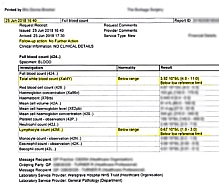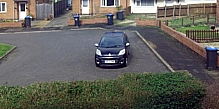
A flocking brilliant job
The second job was the replacement of the collimation screws for the mirrors. I get annoyed that I need three tools to do the adjustments (the primary mirror needs a hex key for three grub-screws and a cross-head screwdriver for three countersunks, the secondary needs a different hex key for three other grubscrews) so I decided to replace the lot with something a bit more user-friendly. A lot of folk go in for the expense of "Bob's Knobs" which are thumbscrews and hence require no tools, but there's a problem at the back end of a Celestron Newtonian - the "pushmi pullyu" screw-pairings on the primary cell are pitched at only 12mm, so large-headed thumbscrews would clash. Besides, they're expensive for what they are, and I'm a cheapskate, so I opted for stainless Phillips panheads. The problem was, what size to get? I emailed the scope's manufacturer with the following question: "Please can you tell me the thread sizes/specifications for the 3 sets of 3 collimation screws (6 on the primary, 3 on the secondary) on a 2007 C8N (the version with the thin-vane spider)?" and received the following reply: "Unfortunately the screws will be different because of various vendors that supply them. So we do not have specs on these. Thank you, Celestron Technical Services" Wow, that was a lot of help. Not! Whatever happened to the idea of standardisation? I had to resort to cadging some thread-gauges. M5 for the primary grubs, M4 for the secondary. A quick order to Stagonset resulted in the swift delivery of two dozen stainless screws various and change from a fiver. The six screws that I actually used (I didn't bother replacing the three cross-head countersunks) were 3-off M4 x 25mm @ 9p each and 3-off M5 x 12mm @ 12p each - simple, effective and way cheaper than posh knobs. Now the only tool required is the small Phillips screwdriver that was supplied with the scope. Sorted.
New screws for the primary

New screws for the secondary
Of course, using panheads instead of inset grubs for the primary meant that the rear mirror cover no longer fitted, so I ditched it and went for an open-ended setup. This is supposed to be a good thing anyway, as it allows quicker mirror-cooling and cuts down on thermal currents in the tube. The screw-holes for fixing the cover were opened out and tapped so that I could fit a set of rubber feet for the tube to stand on.
Showing some (gl)ass!
The last job before the rebuild was the cleaning of the mirrors. So many folk say that you needn't keep them fastidiously clean, but mine were caked with scum. They both had a bath in warm soapy water and a flush-off with distilled water before being rehoused. It was during that process that I confirmed that there was something odd about the primary mirror - the centre-marker wasn't central, as I've long suspected, as it explains why I've often struggled to get the scope collimated correctly. It needed to be fixed. I cut out a disc of paper the same size as the mirror and cut the centre out of it to make a template. Using it as a mask to protect the mirror, I gently peeled off the self-adhesive marker-ring and then stuck it back on in the right place - a full 5mm from where it had been. No wonder collimation had been a dodgy affair!
The properly-centred marker, complete with the scar where it was moved from.
Anyway, after the rebuild was complete I did a full laser-collimation within 5 minutes and the results were better than ever. All I need now is a clear night to do a star-test and all should be well. Progress with the pier continues apace, but I'll tell you about that in a separate post.





Great work, but you've put me off ever buying a 'scope. (Your DIY skills greatly exceed mine.)
Seriously, Celestron have been advertising since I was a lad, and that's a long time ago, but your account suggests that they don't know what they are doing. Was this paritular experience representative or exceptional, in your opinion?
Thanks,
John Green
@John Green:
I can't claim to be much of a judge, as this is the only Celestron that I've owned. It might just be that I got the runt of the litter.
According to many sources, their 9.25" and 11" Schmidt-Cassegrains are highly regarded. I think that Celestron concentrate their QA on the high-end of their range.
That said, mine is a low-tech telescope, and as such was cheap and cheerful, but the mirror centre-marking error is unforgivable, and it's not the only thing that's awry (the secondary is fixed off-centre on its holder - it's 5mm offset to one side, but the adjusting-screws allow me to compensate... just). Most folks who get these cheaper scopes end up "improving" them as time/money allow.
IIRC, these telescopes used to be made in Japan and were excellent. Now they're made in China...
Anyway, for the money it's a good bit of kit now and it gives great views of the sky. Imaging with it is fun too.